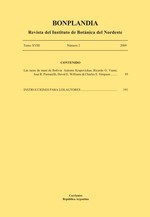Las razas de maní en Bolivia
DOI:
https://doi.org/10.30972/bon.1821339Resumen
Bolivia se destaca como probable lugar de origen del maní cultivado y un centro de variación único en el mundo, lo que señala a Bolivia como una importante fuente de materiales para el mejoramiento de este cultivo de importancia mundial. En este estudio para maní se diferencian para Bolivia 62 razas de maní cultivado de las cuales, 42 pertenecen a Arachis hypogaea L subsp. hypogaea var. hypogaea, 17 a A. hypogaea susbp. fastigiata Waldron var. fastigiata, 1 a A. hypogaea susbp. fastigiata var. vulgaris y 2 a A. hypogaea subsp. fastigiata var. peruviana Krapov. & W. C. Gregory. Bolivia constituye un centro de variación independiente pues sus razas son exclusivas de su territorio, salvo muy pocas excepciones. Bolivia como unidad, se caracteriza por las razas "Crema", "Colorado San Simón", "Bayo americano", "Overo" y "Overo carenado", que se cultivan en todo el país. Se pueden delimitar algunas regiones de mayor diversidad: la región de los Yungas de La Paz, donde se coleccionaron 11 razas de las cuales 3 son exclusivas y la región montañosa de Santa Cruz y Cochabamba, con 18 razas de las cuales 6 son exclusivas. Estas dos regiones pertenecen a la cuenca del Amazonas. Unatercera región se encuentra en el Departamento de Tarija, perteneciente a la cuenca del Plata, donde se coleccionaron 14 razas, de las cuales 2 son exclusivas. Todas estas razas pertenecen a la var. hypogaea. La subsp. fastigiata, presenta un centro de variación muy notable en la cuenca del río Beni, donde en un área muy pequeña se coleccionaron 10 razas, de las cuales 9 son exclusivas. Se destaca Bolivia como un centro de variación único en el mundo y la gran variabilidad del maní señala a Bolivia como una importante fuente de posibilidades para el mejoramiento de este cultivoDescargas
Los datos de descargas todavía no están disponibles.
Descargas
Publicado
2009-07-01
Cómo citar
Krapovickas, A., Vanni, R. O., Pietrarelli, J. R., Williams, D. E., & Simpson, C. E. (2009). Las razas de maní en Bolivia. Bonplandia, 18(2), 95–189. https://doi.org/10.30972/bon.1821339
Número
Sección
Artículos originales
Licencia
Declaration of Adhesion to Open Access
- All contents of Bonplandia journal are available online, open to all and for free, before they are printed.
Copyright Notice
- Bonplandia magazine allows authors to retain their copyright without restrictions.
- The journal is under a Creative Commons Attribution 4.0 International license.















.jpg)


